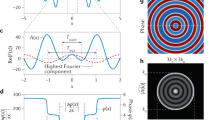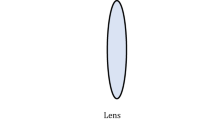Abstract
The past decade has seen an intensive effort to achieve optical imaging resolution beyond the diffraction limit. Apart from the Pendry–Veselago negative index superlens1, implementation of which in optics faces challenges of losses and as yet unattainable fabrication finesse, other super-resolution approaches necessitate the lens either to be in the near proximity of the object or manufactured on it2,3,4,5,6, or work only for a narrow class of samples, such as intensely luminescent7,8 or sparse9 objects. Here we report a new super-resolution microscope for optical imaging that beats the diffraction limit of conventional instruments and the recently demonstrated near-field optical superlens and hyperlens. This non-invasive subwavelength imaging paradigm uses a binary amplitude mask for direct focusing of laser light into a subwavelength spot in the post-evanescent field by precisely tailoring the interference of a large number of beams diffracted from a nanostructured mask. The new technology, which—in principle—has no physical limits on resolution, could be universally used for imaging at any wavelength and does not depend on the luminescence of the object, which can be tens of micrometres away from the mask. It has been implemented as a straightforward modification of a conventional microscope showing resolution better than λ/6.
This is a preview of subscription content, access via your institution
Access options
Subscribe to this journal
Receive 12 print issues and online access
$259.00 per year
only $21.58 per issue
Buy this article
- Purchase on Springer Link
- Instant access to full article PDF
Prices may be subject to local taxes which are calculated during checkout




Similar content being viewed by others
References
Pendry, J. B. Negative refraction makes a perfect lens. Phys. Rev. Lett. 85, 3966–3969 (2000).
Zhang, X. & Liu, Z. Superlenses to overcome the diffraction limit. Nature Mater. 7, 435–441 (2008).
Rho, J. et al. Spherical hyperlens for two-dimensional sub-diffractional imaging at visible frequencies. Nature Commun. 1, 143 (2010).
Smolyaninov, I. I., Hung, Y-J. & Davis, C. C. Magnifying superlens in the visible frequency range. Science 315, 1699–1701 (2007).
Lee, J. Y. et al. Near-field focusing and magnification through self-assembled nanoscale spherical lenses. Nature 460, 498–501 (2009).
Wang, Z. et al. Optical virtual imaging at 50 nm lateral resolution with a white-light nanoscope. Nature Commun. 2, 218 (2011).
Hell, S. W. Toward fluorescence nanoscopy. Nature Biotech. 21, 1347–1355 (2003).
Huang, B., Wang, W., Bates, M. & Zhuang, X. Three-dimensional super-resolution imaging by stochastic optical reconstruction microscopy. Science 319, 810–813 (2008).
Gazit, S., Szameit, A., Eldar, Y. C. & Segev, M. Super-resolution and reconstruction of sparse sub-wavelength images. Opt. Express 17, 23920–23946 (2009).
Berry, M. V. & Popescu, S. Evolution of quantum superoscillations and optical superresolution without evanescent waves. J. Phys. A 39, 6965–6977 (2006).
Kempf, A. Black holes, bandwidths and Beethoven. J. Math. Phys. 41, 2360–2374 (2000).
Huang, F. M., Zheludev, N., Chen, Y. & Javier Garcia de Abajo, F. Focusing of light by a nanohole array. Appl. Phys. Lett. 90, 091119 (2007).
Toraldo di Francia, G. Super-gain antennas and optical resolving power. Nuovo Cimento. Suppl. 9, 456–438 (1952).
Hegedus, Z. S. & Sarafis, V. Superresolving filters in confocally scanned imaging systems. J. Opt. Soc. Am. A 3, 1892–1896 (1986).
Wang, H., Shi, L., Lukyanchuk, B., Sheppard, C. & Chong, C. T. Creation of a needle of longitudinally polarized light in vacuum using binary optics. Nature Photon. 2, 501–505 (2008).
Ferreira, P. & Kempf, A. Superoscillations: Faster than the Nyquist rate. IEEE Trans. Signal Proces. 54, 3732–3740 (2006).
Yakir Aharonov, D. A. & Vaidman, L. How the result of a measurement of a component of the spin of a spin-1/2 particle can turn out to be 100. Phys. Rev. Lett. 60, 1351–1354 (1988).
Zheludev, N. I. Super-gain antennas and optical resolving power. Nature Mater. 7, 420–422 (2008).
Huang, F. M. & Zheludev, N. I. Super-resolution without evanescent waves. Nano Lett. 9, 1249–1254 (2009).
Mote, R. G., Yu, S. F., Ng, B. K., Zhou, W. & Lau, S. P. Near-field focusing properties of zone plates in visible regime—new insights. Opt. Express 16, 9554–9564 (2008).
Li, J-H., Cheng, Y-W., Chue, Y-C., Lin, C-H. & Sheu, T. W. The influence of propagating and evanescent waves on the focusing properties of zone plate structures. Opt. Express 17, 18462–18468 (2009).
Li, J-H., Lin, C-H., Tsai, Y-J., Cheng, Y-W. & Sheu, T. W-H. Modulation of optical focusing by using optimized zone plate structures. Opt. Express 18, 22772–22780 (2010).
Grbic, A., Merlin, R., Thomas, E. & Imani, M. Near-field plates: Metamaterial surfaces/arrays for subwavelength focusing and probing. Proc. IEEE 99, 1806–1815 (2011).
Jin, N. & Rahmat-Samii, Y. Advances in particle swarm optimization for antenna designs: Real-number, binary, single-objective and multiobjective implementations. IEEE Trans. Antenn. Propag. 55, 556–567 (2007).
O’Shea, D. C., Suleski, T. J., Kathman, A. D. & Prather, D. W. Diffractive Optics: Design, Fabrication, and Test (SPIE, 2004).
Acknowledgements
This work was supported by the UK’s Engineering and Physical Sciences Research Council under the Basic Technology (EP/F040644/1) and Nanostructured Photonic Metamaterials (EP/G060363/1) Programmes. The authors thank K. Dholakia, M. Mazilu, Y. Chen and A. D. Boardman for fruitful discussions and J. Y. Ou for assistance with nanofabrication.
Author information
Authors and Affiliations
Contributions
The principle of super-oscillatory imaging was suggested by N.I.Z. with contributions from M.R.D. and J.E.C.; J.L. and M.R.D. developed mathematical algorithms for designing the binary super-oscillatory lens and computed the lens design. T.R. nanofabricated the binary mask and test objects. Optical characterization and modelling of the super-oscillatory lens performance was undertaken by E.T.F.R., S.S. and T.R. E.T.F.R. and N.I.Z. designed the opto-mechanical construction of the imaging apparatus with contributions from J.E.C. E.T.F.R. wrote the imaging instrument software, performed the imaging experiments and data post-processing. N.I.Z. supervised the project and wrote the manuscript with contributions from all co-authors. All authors contributed to the discussions of results and planning of experiments.
Corresponding author
Ethics declarations
Competing interests
The authors declare no competing financial interests.
Supplementary information
Supplementary Information
Supplementary Information (PDF 238 kb)
Rights and permissions
About this article
Cite this article
Rogers, E., Lindberg, J., Roy, T. et al. A super-oscillatory lens optical microscope for subwavelength imaging. Nature Mater 11, 432–435 (2012). https://doi.org/10.1038/nmat3280
Received:
Accepted:
Published:
Issue Date:
DOI: https://doi.org/10.1038/nmat3280
This article is cited by
-
Single atom in a superoscillatory optical trap
Communications Physics (2023)
-
The singularities of light: intensity, phase, polarisation
Light: Science & Applications (2023)
-
Far-field super-resolution chemical microscopy
Light: Science & Applications (2023)
-
An entropy-controlled objective chip for reflective confocal microscopy with subdiffraction-limit resolution
Nature Communications (2023)
-
Ultra-thin light-weight laser-induced-graphene (LIG) diffractive optics
Light: Science & Applications (2023)



